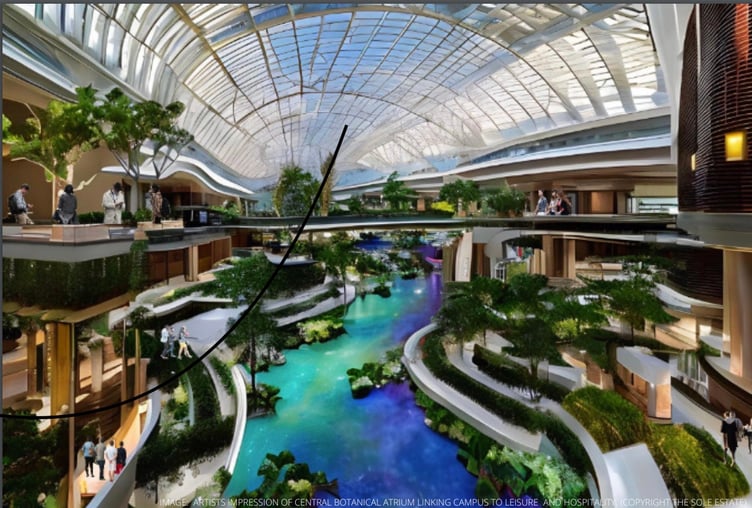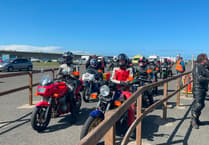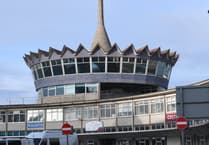A potential multi-billion pound project could transform the south of the island.
The bold, new plan, which has been presented to the Department for Enterprise and the Chamber of Commerce, proposes the creation of a university campus, green energy complex, 6,000 units of accommodation and a rail line.
Called the Biosphere Innovation Gateway – which had a £7 billion price tag in a draft document – has been put forward by island-based The Sole Estate.
The plan includes a green data complex and a university campus, which all aim to stimulate the island’s economy.
Whilst the plans say that the development would be next to the airport, no specific locations have been proposed.
Its organisers say that the capital will come from ‘institutional investment’, citing interest from parties in the United States.
A spokesperson for The Sole Estate said: ‘Raising capital for large-scale net zero projects such as these is made possible through institutional investments from global financiers, US banks, hedge funds and pension funds that promote progressive environmental development opportunities. Similarly, an Isle of Man project would be independently financed, and at no cost to the taxpayer.’
They added: ‘We are currently in discussion with the Department for Enterprise to determine an 18-month feasibility and evaluation period for a proposed research park and knowledge community.
‘At this stage, a specific location has not yet been decided. It’s still early days for such an ambitious offering on the Isle of Man.’
Although no end date has been given yet, It is proposed that the project is partially built by 2029.
Part of the plan is to have a university campus, which would be centred around four key faculties. These are space and planetary science, energy and information technology, heritage and built environment, and environmental social governance.
It is proposed that the university campus would be home to 4,500 students, including 1,500 undergraduates and 3,000 postgraduates, with 500 academic staff and university faculty.
The organisers’ hope is that the university would specialise in emerging industries, and help boost the island’s commercial interest in the economy.
The second element of the project is a green data complex and ‘renewables power facility’. It is proposed that the 100-megawatt green data centre would act as a data storage facility. A proposed £300 million ‘renewables power facility would aim to offset carbon emissions whilst providing green energy to homes and businesses in the south of the island.
The final aspect of the project would be a community consisting of an ‘eco-neighbourhood’, commercial and retail units and a ‘heritage rail line’.
The accommodation would be split into a ‘scholars’ village’ which would have 1,800 studio-style flats, as well as a library, students’ union and ‘lifestyle amenities’.
There would also be a ‘Professionals’ Park’ and this would have 3,300 two- to three-bedroom flats.
Here there would be the majority of university faculty buildings, hospitality and leisure facilities, retail and a 400-room hotel.
‘The Manor Quarter’ would have 500 units of three- to four-bedroom single family style town houses. All of the accommodation would be rental, with the estimated monthly costs for occupants being between £1,100 to £3,000 depending on accommodation size.
As well as accommodation and retail units, the ‘Mixed Heritage Rail Community’ would include a rail line connecting the Green Energy Complex University Campus and the neighbourhoods included in the plan.
Taking inspiration from the London tube system, monorail and Japanese high speed trains, a rail service may be extended to create a line to Douglas.
The plans have been under development for the past 22 months. Included on the advisory board is former government minister John Shimmin and Ramsey commissioner Adam Beighton.
The spokesperson for The Sole Estate explained what sparked the project.
They said: ‘Since the announcement of the UK Government’s intention to create 12 new “Canary Wharf Style” low-tax investment zones across Britain, the questions of what this sort of infrastructure could mean to places like the Isle of Man would surely emerge.
‘Over the past two years, a team of highly experienced UK development professionals and international academic researchers have been working on potential built environment solutions for the commercial success of several small island and coastal regions.
‘In addition to potential sites, the exact population, construction phases, building partners, and even funding amount must be discovered through a rigorous analysis.
‘This research and development project will take time and it’s necessary that we get it right. We’re looking to move from a place of possibility to probability and inevitably a position of certainty for delivering the targets outlined in the government’s economic strategy.’
The Sole Estate, which has developed the idea, is a company based on the premise of the academic work of Ian James Clanton, who goes by the name H.M. The Sole.
In 2017, Mr Clanton tried to raise £1 billion for a 180-acre floating city, an earth-station which aimed to be a permanent discovery campus dedicated to advancing planetary science and prototyping new innovations.
The project was titled the ‘Ecological Geophysical Galleon’ a.k.a. The E.G.G. Kingdom.



-(1).jpeg?width=209&height=140&crop=209:145,smart&quality=75)

Comments
This article has no comments yet. Be the first to leave a comment.